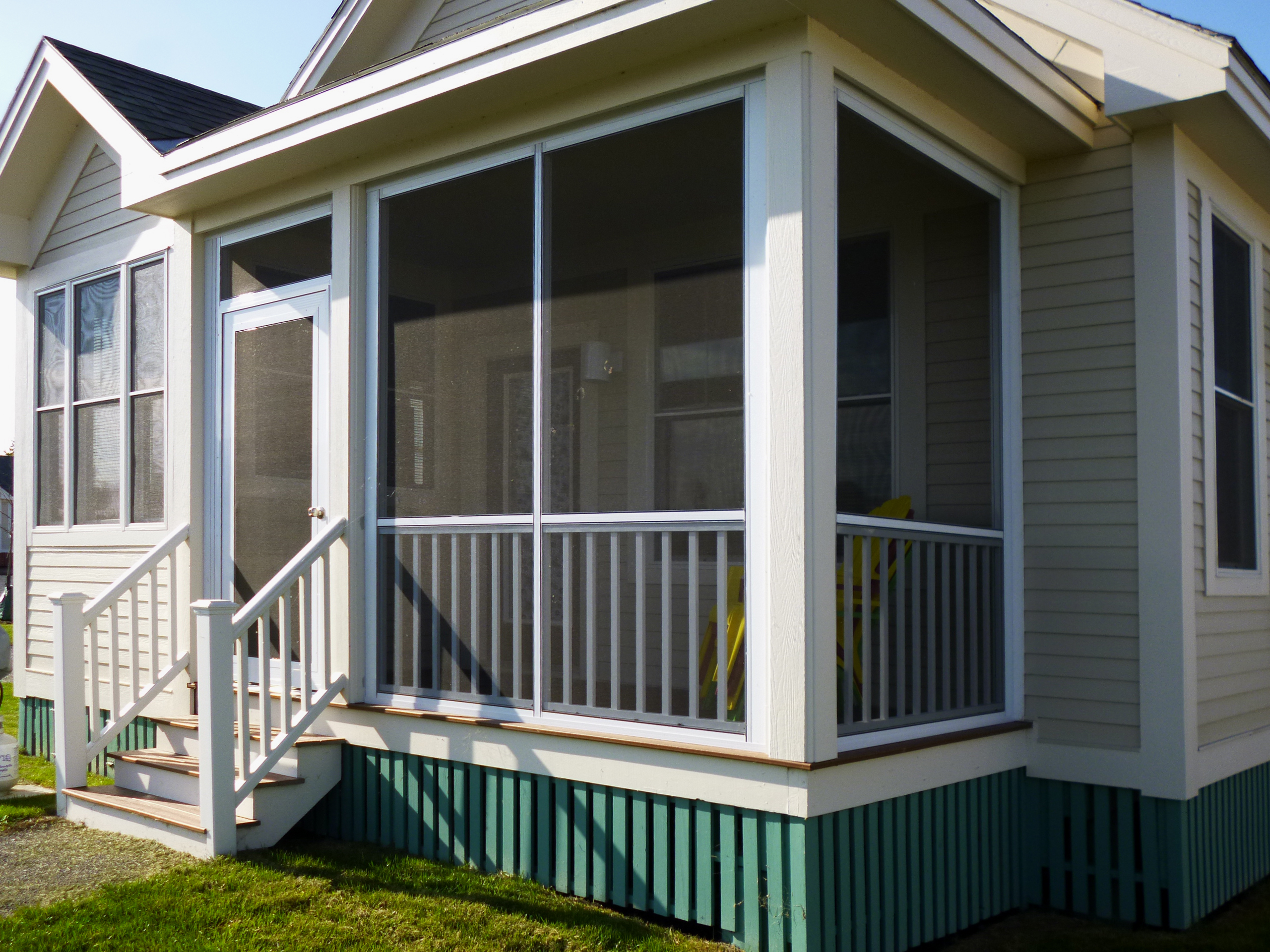If you’re a Maryland homeowner looking to extend your outdoor living season, you’ve likely considered adding either a screen room or a three-season room to your property. Both options offer unique benefits, but understanding how each performs in Maryland’s distinct climate is crucial to making the right investment for your home.
At Custom Design & Build LLC, we’ve helped countless Harford County homeowners navigate this decision. Let’s break down the differences and help you determine which option best suits your lifestyle and Maryland’s weather patterns.
Understanding Maryland’s Climate
Maryland experiences all four seasons with hot, humid summers and cold winters. Our state sits in a unique climate zone where:
- Summers bring temperatures in the 80s and 90s with high humidity
- Winters see temperatures regularly dropping below freezing, with occasional snowfall
- Spring and fall offer mild, pleasant weather—often the most comfortable times of year
- Precipitation occurs year-round, with occasional severe thunderstorms in summer
This varied climate means your outdoor space addition needs to handle everything from sweltering August afternoons to chilly November evenings.
What is a Screen Room?
A screen room is an outdoor structure enclosed with screening material instead of solid walls. It typically features:
- Mesh screening on all sides for ventilation and insect protection
- A roof to provide shelter from rain and sun
- Open-air design that allows natural breezes to flow through
- Simple construction with a focus on affordability
Screen Room Benefits in Maryland
Perfect for Summer Use Maryland’s hot, humid summers make screen rooms ideal from May through September. The open design allows for maximum airflow, creating a comfortable space even on warm evenings without relying on air conditioning.
Bug-Free Outdoor Living Maryland’s mosquito season can be relentless, especially near the Chesapeake Bay and in areas with standing water. A screen room lets you enjoy summer evenings without becoming a buffet for insects.
Cost-Effective Solution Screen rooms are generally more affordable than three-season rooms, making them an excellent entry point for homeowners wanting to expand their outdoor living space on a budget.
Quick Installation With simpler construction requirements, screen rooms can often be completed faster than more complex three-season rooms.
Screen Room Limitations
Limited Season Once temperatures drop in late October, screen rooms become too cold for comfortable use. You’ll typically get 5-6 months of use in Maryland’s climate.
No Climate Control Without insulation or the ability to add heating/cooling, you’re at the mercy of outdoor temperatures.
Less Privacy The transparent screening offers minimal visual privacy from neighbors or passersby.
Weather Vulnerability While protected from rain, screen rooms offer no protection from wind, making them uncomfortable during storms or breezy days.
What is a Three-Season Room?
A three-season room is a more substantial structure with:
- Glass windows (often operable) instead of screens
- Insulated walls and roof for better temperature control
- Electrical capabilities for lighting, fans, and space heaters
- More finished interior similar to an indoor room
Three-Season Room Benefits in Maryland
Extended Usability In Maryland, a properly designed three-season room can be comfortable from March through November—giving you 8-9 months of use annually. With a space heater, some homeowners even use them on mild winter days.
Weather Protection Glass windows shield you from Maryland’s unpredictable weather—sudden rain showers, gusty winds, and temperature swings that are common in our region.
Versatile Space A three-season room can serve multiple purposes: morning coffee spot, home office, exercise room, or entertainment area. The controlled environment makes it more functional year-round.
Increased Home Value The substantial construction and extended usability of three-season rooms typically add more value to your home than screen rooms.
Better Temperature Management While not fully climate-controlled like a four-season room, the insulation and ability to add portable heating or cooling units make three-season rooms comfortable during Maryland’s shoulder seasons.
Three-Season Room Limitations
Higher Initial Investment Three-season rooms cost significantly more due to windows, insulation, electrical work, and more complex construction.
Longer Construction Time The additional components and finishing work mean a longer project timeline.
Still Not Year-Round During Maryland’s coldest months (December through February), three-season rooms remain too cold for regular use without significant heating costs.
Less Airflow in Summer While windows can open, three-season rooms don’t offer the same natural ventilation as screen rooms during peak summer heat.
Making the Right Choice for Your Maryland Home
Consider a Screen Room if you:
- Primarily want relief from bugs during summer months
- Love the feeling of being outdoors with a light breeze
- Have a limited budget for your outdoor project
- Already have other indoor living spaces and want a casual summer retreat
- Live in an area with a nice summer breeze (near water or elevated properties)
Consider a Three-Season Room if you:
- Want to maximize your investment with extended seasonal use
- Need a functional space for activities like working, exercising, or hobbies
- Live in a neighborhood where you’d appreciate more privacy
- Enjoy Maryland’s beautiful spring and fall weather and want protection from unpredictable conditions
- Plan to use the space for entertaining guests throughout most of the year
The Best of Both Worlds: Convertible Options
Some Maryland homeowners choose a hybrid approach—starting with a three-season room structure but incorporating removable panels or retractable screens. This gives you:
- Screen-room airflow in summer
- Glass protection in spring and fall
- Maximum flexibility for Maryland’s changing seasons
While this option requires a higher initial investment, it provides year-round versatility that many find worthwhile.
Local Building Considerations in Harford County
When planning your project in Harford County and surrounding Maryland areas, keep in mind:
- Permit requirements vary by county and municipality
- HOA restrictions may limit certain designs or placement
- Property setbacks dictate how close structures can be to property lines
- Foundation requirements depend on soil conditions and frost lines in Maryland
At Custom Design & Build LLC, we handle all permitting and ensure your project meets local building codes and regulations.
Design Tips for Maryland’s Climate
Regardless of which option you choose, consider these Maryland-specific design elements:
Orientation Matters
- South-facing rooms get maximum sunlight (great for spring/fall, but can overheat in summer)
- North-facing rooms stay cooler in summer but receive less natural warmth
- East-facing rooms catch beautiful morning light
Roof Considerations
- Solid, insulated roofs perform better in all seasons than glass roofs in Maryland
- Adequate roof pitch helps with snow load during winter storms
- Consider adding ceiling fans for summer comfort
Flooring Choices
- Tile or concrete floors work well in both options and handle moisture
- Composite decking provides a warmer feel but requires drainage considerations
- Area rugs can add comfort and are easily removed for cleaning
Furniture Selection
- Choose weather-resistant furniture for screen rooms
- Three-season rooms allow for more traditional indoor furniture options
- Consider storage solutions for off-season cushions and accessories
Return on Investment
In the Maryland real estate market, outdoor living spaces are highly desirable. While specific ROI varies by location and quality:
- Screen rooms typically recoup 50-70% of costs at resale
- Three-season rooms often recoup 60-80% of costs, with higher returns in desirable areas
- Both options make your home more attractive to buyers who value outdoor living
Beyond resale value, the real return comes from the enjoyment and quality of life these spaces provide for your family.
Maintenance Considerations
Screen Room Maintenance:
- Annual screen inspection and repair of tears
- Cleaning screens 1-2 times per season
- Removing debris from roof and gutters
- Checking for pest damage
Three-Season Room Maintenance:
- Window cleaning and track maintenance
- Inspecting weather stripping and seals
- Checking electrical components
- Seasonal deep cleaning
Both options require minimal maintenance compared to the enjoyment they provide.
Ready to Expand Your Outdoor Living Space?
Whether you choose a screen room for casual summer enjoyment or a three-season room for extended seasonal use, the most important factor is selecting a design that fits your lifestyle and Maryland’s unique climate challenges.
At Custom Design & Build LLC, we specialize in creating custom outdoor living spaces tailored to Harford County’s climate and our clients’ specific needs. Our team will help you evaluate your property, discuss your goals, and design a solution that maximizes your investment.
Contact us today for a free consultation and let’s discuss which option is perfect for your Maryland home. With over 87 five-star reviews and years of experience building in our local climate, we’ll ensure your project is built to last and designed for year-round enjoyment.
Custom Design & Build LLC proudly serves Harford County and surrounding Maryland areas with expert deck building, screen rooms, three-season rooms, and complete outdoor living solutions. Based in Fallston, MD, we’re your local experts in creating outdoor spaces that enhance your lifestyle and home value.






